What Are Carbon Nanotubes Used For
Carbon nanotubes – what they are, how they are made, what they are used for
What are carbon nanotubes?
Carbon nanotubes (CNTs) are cylindrical molecules that consist of rolled-up sheets of single-layer carbon atoms (graphene). They can be single-walled (SWCNT) with a diameter of less than 1 nanometer (nm) or multi-walled (MWCNT), consisting of several concentrically interlinked nanotubes, with diameters reaching more than 100 nm. Their length can accomplish several micrometers or even millimeters.
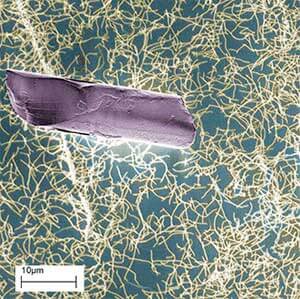
The regal structure is a man hair fragment, with a diameter of about 80 to 100 thousand nanometers and in the background is a network of single-walled carbon nanotubes. (Image: Jirka Cech)
Like their building block graphene (Why not read our all-encompassing tutorial on graphene – which includes a fantastic infographic), CNTs are chemically bonded with spii bonds, an extremely strong form of molecular interaction.
This feature combined with carbon nanotubes' natural inclination to rope together via van der Waals forces, provide the opportunity to develop ultra-high strength, low-weight materials that possess highly conductive electrical and thermal properties. This makes them highly attractive for numerous applications.
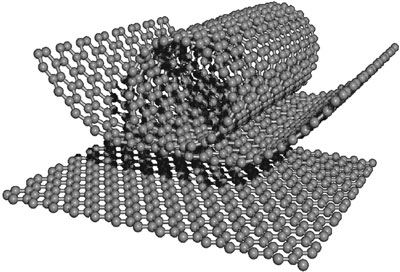
Carbon allotropes
Carbon is the fourth-most-abundant chemical element in the universe and, depending on the arrangements of carbon atoms, takes on a wide diversity of forms, chosen allotropes. Carbon allotropes exhibit unique properties of strength and electric electrical conductivity.
Solid carbon at room temperature has ii classical structures: diamond and graphite. In 1985 the discovery of the beingness of a third and new carbon allotrope containing sixty perfectly symmetrically bundled carbon atoms (too known equally C60, fullerene, or buckyballs) meant a major breakthrough and opened a novel field of carbon nanochemistry. Then, in 1991, carbon nanotubes were discovered and graphene in 2004.
Electrical properties of carbon nanotubes
The rolling-upward direction (rolling-upwards or chiral vector) of the graphene layers determines the electrical properties of the nanotubes. Chirality describes the angle of the nanotube'southward hexagonal carbon-atom lattice.
Armchair nanotubes – so called because of the armchair-like shape of their edges – accept identical chiral indices and are highly desired for their perfect conductivity. They are unlike zigzag nanotubes, which may be semiconductors. Turning a graphene sheet a mere thirty degrees will alter the nanotube it forms from armchair to zigzag or vice versa.
While MWCNTs are e'er conducting and achieve at least the aforementioned level of conductivity equally metals, SWCNTs' conductivity depends on their chiral vector: they can behave like a metallic and exist electrically conducting; display the backdrop of a semi-conductor; or exist non-conducting. For case, a slight change in the pitch of the helicity tin transform the tube from a metallic into a big-gap semiconductor.
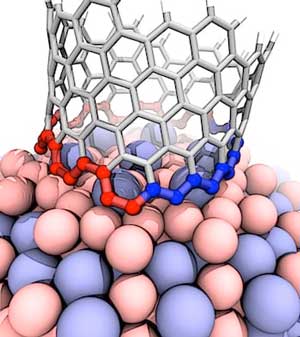
Properties of carbon nanotubes
Apart from their electrical properties, which they inherit from graphene, CNTs also have unique thermal and mechanical properties that make them intriguing for the development of new materials:
All these backdrop make carbon nanotubes ideal candidates for electronic devices, chemic/electrochemical and biosensors, transistors, electron field emitters, lithium-ion batteries, white low-cal sources, hydrogen storage cells, cathode ray tubes (CRTs), electrostatic discharge (ESD) and electrical-shielding applications.
Departure betwixt carbon nanotubes and carbon nanofibers
Please note that carbon nanotubes are different than carbon nanofibers (CNFs). CNFs are commonly several micrometers long and have a diameter of well-nigh 200 nm. Carbon fibers have been used for decades to strengthen compound simply they practise not have the same lattice structure equally CNTs. Instead, they consist of a combination of several forms of carbon and/or several layers of graphite, which are stacked at various angles on amorphous carbon (where atoms do not arrange themselves in ordered structures). CNFs have like backdrop as CNTs, merely their tensile strength is lower owing to their variable structure and they are non hollow inside.
For starters, you could watch these five curt videos most carbon nanotubes:
Who discovered carbon nanotubes?
Thousands of papers are beingness published every year on CNTs or related areas and most of these papers give credit for the discovery of CNTs to Sumio Iijima who, in 1991, published a ground-breaking paper in Nature ("Helical microtubules of graphitic carbon") reporting the discovery of multi-walled carbon nanotubes.
On taking a cursory look at the scientific literature, one might get the impression that Iijima is the de facto discoverer of carbon nanotubes. Of course, in that location is no uncertainty that he has made two seminal contributions to the field, however a careful assay of the literature suggests that certainly he is non the commencement one who has reported the existence of CNTs.
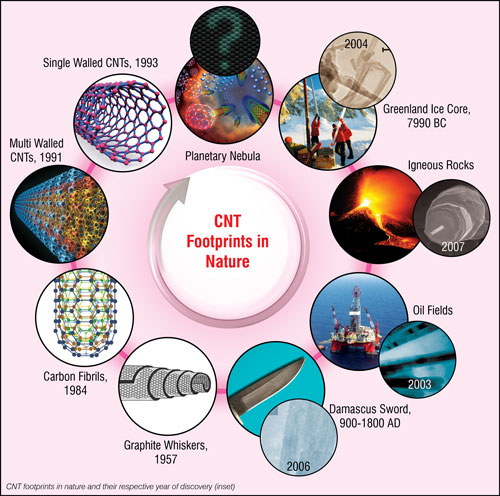
How are carbon nanotubes made?
Iii main methods are currently available for the production of CNTs: arc belch, laser ablation of graphite, and chemical vapor deposition (CVD).
In the commencement ii processes, graphite is combusted electrically or by means of a light amplification by stimulated emission of radiation, and the CNTs developing in the gaseous stage are separated. All three methods require the use of metals (e.g. atomic number 26, cobalt, nickel) equally catalysts.
CVD process
The CVD process currently holds the greatest promise, since it allows the production of larger quantities of CNTs under more easily controllable atmospheric condition and at lower price. In the CVD process, manufacturers tin can combine a metal catalyst (such as atomic number 26) with carbon-containing reaction gases (such every bit hydrogen or carbon monoxide) to form carbon nanotubes on the catalyst inside a high-temperature furnace.
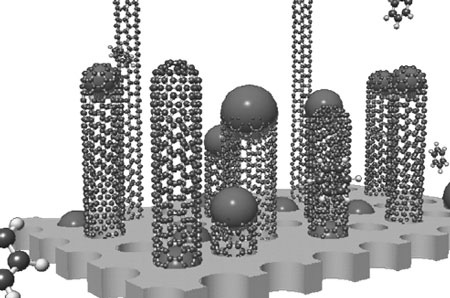
The CVD process can exist purely catalytic or plasma-supported. The latter requires slightly lower temperatures (200-500°C) than the catalytic process (up to 750°C) and aims at producing 'lawn-similar' CNT growth.
Purification
Even though synthetic techniques accept been improved to obtain high-purity carbon nanotubes, the germination of byproducts containing impurities such equally metal encapsulated nanoparticles, metal particles in the tip of a carbon nanotube, and amorphous carbon has been an unavoidable phenomenon, because the metal nanoparticles are essential for the nanotube growth.
These foreign nanoparticles, also every bit structural defects that occurred during synthesis, have the unfortunate implication that they modify the physico-chemic properties of the produced carbon nanotubes.
That's why carbon nanotubes need to be purified with the assist of diverse methods such as acrid handling or ultrasound at the end of the production process.
Applications of carbon nanotubes and their uses
CNTs are well-suited for near whatsoever application requiring high strength, immovability, electric electrical conductivity, thermal conductivity and lightweight properties compared to conventional materials.
Currently, CNTs are mainly used as additives to synthetics. CNTs are commercially bachelor equally a pulverization, i.e. in a highly tangled-up and agglomerated form. For CNTs to unfold their particular properties they need to be untangled and spread evenly in the substrate.
Another requirement is that CNTs demand to be chemically bonded with the substrate, east.thousand. a plastic material. For that purpose, CNTs are functionalized, i.due east. their surface is chemically adapted for optimal incorporation into dissimilar materials and for the specific application in question.
Carbon nanotubes can also be spun into fibers, which non just hope interesting possibilities for specialty textiles only may also help realize a particularly utopian projection – the space elevator.
Materials
Carbon nanotube enabled nanocomposites take received much attention as a highly attractive culling to conventional composite materials due to their mechanical, electric, thermal, barrier and chemical properties such every bit electrical conductivity, increased tensile force, improved rut deflection temperature, or flame retardancy.
These materials promise to offer increased wear resistance and breaking strength, antistatic properties also as weight reduction. For instance, it has been estimated that advanced CNT composites could reduce the weight of aircraft and spacecraft by up to xxx%.
These composite materials already find use in
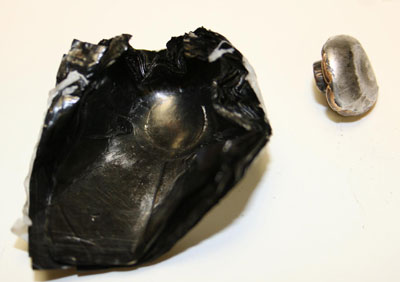
Catalysis
What makes carbon nanotubes so attractive for catalysis is their exceptionally loftier surface expanse combined with the power to attach substantially whatever chemic species to their sidewalls. Already, CNTs have been used as catalysts in many relevant chemical processes, however, controlling their catalytic activity is non easy.
Initially, carbon nanotubes have been combined with molecules via very strong bonds (covalent bonds) that lead to very stable compounds. Such connection, however, implies a modify in the structure of the nanotube and therefore in its backdrop.
It would be coordinating to nailing an advertisement to a post using a thumbtack: the union is strong, simply it leaves a hole in both the advertisement and the mail service. Weak non-covalent forces have also been used, which go along the structure of the nanotubes intact, simply typically yield kinetically unstable compounds. The comparing in this instance would be to tape the ad to the post. Neither the advertisement nor the post is damaged, but the union is much weaker.
To overcome this event, researchers already are developing methods for the chemical modification of carbon nanotubes past mechanical bonding, the start example of mechanically interlocked carbon nanotubes (MINTs). This blazon of compounds is as stable as covalent compounds, merely at the aforementioned time equally respectful of the initial structure as the non-covalent compounds.
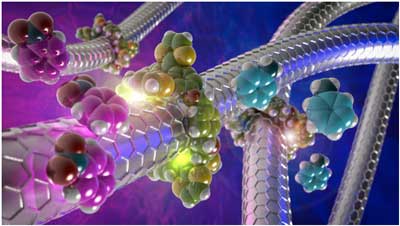
Transistors
Despite the rise of graphene and other 2-dimensional (2D) materials, semiconducting single-walled carbon nanotubes are even so regarded as strong candidates for the next generation of high-performance, ultra-scaled and thin-moving picture transistors as well as for opto-electronic devices to supplant silicon electronics (read more: "xx years of nanotube transistors").
One of the crucial questions is if CNT transistors can offer performance advantages over silicon at sub-x nm lengths.
There have been mixed opinions in the nanoelectronics customs regarding whether or not CNT transistors would maintain their impressive performance at extremely scaled lengths. Some argued that the very small effective mass of the carriers would contribute to a tunneling phenomena that would cause the devices to breakup around 15 nm – an stance supported by the few theoretical studies that explored nanotube devices at such dimensions.
Meanwhile, others remained convinced that the ultrathin trunk of unmarried-walled carbon nanotubes – simply 1 nm in bore – would allow for excellent transistor behavior even down to the sub-x nm range.
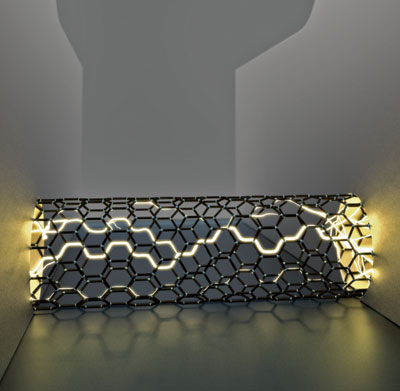
So far researchers have achieved just promising experimental results and at this betoken there remain numerous challenges related to integrating CNT transistors into industrial-scale fleck manufacturing.
Sensors
The group of Cees Dekker paved the way for the evolution of CNT-based electrochemical nanosensors by demonstrating the possibilities of SWCNTs as quantum wires and their effectiveness in the development of field-consequence transistors.
Many studies have shown that although CNTs are robust and inert structures, their electrical backdrop are extremely sensitive to the effects of charge transfer and chemic doping by various molecules.
Most sensors based on CNTs are field effect transistors (FET) – although CNT are robust and inert structures, their electrical properties are extremely sensitive to the effects of charge transfer and chemical doping by various molecules. CNTs-FETs have been widely used to detect gases such equally greenhouse gases in environmental applications.
The functionalization of CNTs is of import for making them selective to the target analyte. Different types of sensors are based based on molecular recognition interactions between functionalism CNT and target analytes.
For example, researchers have developed flexible hydrogen sensors using single-walled carbon nanotubes decorated with palladium nanoparticles.
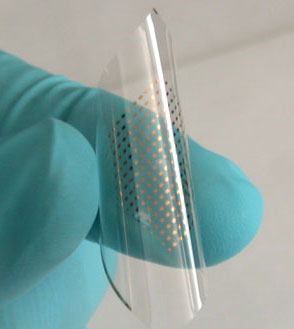
Nano inks
Ink formulations based on CNT dispersions are bonny for printed electronics applications such equally transparent electrodes, RFID tags, thin-film transistors, light-emitting devices, and solar cells (read more than: "Conductive nanomaterials for printed electronics applications").
Electrodes
Carbon nanotubes have been widely used every bit electrodes for chemical and biological sensing applications and many other electrochemical studies. With their unique 1-dimensional molecular geometry of a large surface expanse coupled with their excellent electric properties, CNTs have become important materials for the molecular engineering of electrode surfaces where the development of electrochemical devices with region-specific electron-transfer capabilities is of paramount importance.
Displays
Given their high electrical electrical conductivity, and the incredible sharpness of their tip (the smaller the tips' radius of curvature, the more concentrated the electric field, the college field emission), carbon nanotubes are considered the most promising cloth for field emitters and a applied case are CNTs as electron emitters for field emission displays (FED).
Field emission display (FED) technology makes possible a new class of large area, high resolution, low cost apartment panel displays. Even so, FED manufacturing requires CNT to be grown in precise sizes and densities. Height, diameter and tip sharpness affect voltage, while density affects current.
Buckypapers
Buckypapers could find numerous applications: Equally one of the most thermally conductive materials known, buckypaper could lead to the development of more efficient rut sinks for fries; a more energy-efficient and lighter groundwork illumination material for displays; a protective material for electronic circuits from electromagnetic interference due to its unusually loftier electric current-carrying chapters; or switchable surfaces (see: "Nanotechnology paper for switchable surfaces").
Optoelectronic and photonic applications
While individual nanotubes generate discrete fine peaks in optical absorption and emission, macroscopic structures consisting of many CNTs gathered together also demonstrate interesting optical beliefs.
For example, a millimeter-long bundle of aligned MWCNTs emits polarized incandescent light by electric current heating and SWCNT bundles are giving higher brightness emission at lower voltage compared with conventional tungsten filaments.
Nanomedicine and biotechnology
Carbon nanomaterials such as nanotubes or graphene not only are widely researched for their potential uses in industrial applications, they also are of great interest to biomedical engineers working on nanotechnology applications.
There is considerable interest in using CNTs for various biomedical applications. The physical backdrop of CNTs, such as mechanical strength, electric electrical conductivity, and optical properties, could be of great value for creating avant-garde biomaterials.
Carbon nanotubes can also be chemically modified to present specific moieties (e.g., functional groups, molecules, and polymers) to impart properties suited for biological applications, such every bit increased solubility and biocompatibility, enhanced material compatibility and cellular responsiveness.
Yet, the result of cytotoxicity of CNTs is an area that has already attracted much research interest and has not resulted in a definitive answer yet. Given the inconclusive state of these nanotoxicology studies researchers says that more systematic biological evaluations of CNTs having diverse chemic and physical properties are warranted in order to determine their precise pharmacokinetics, cytotoxicity, and optimal dosages.
Filtration
High-flow membranes are an important role of future energy-efficient water purification. Already, researchers have demonstrated efficient water send in carbon nanotubes with openings of less than one nanometer.
When embedded in fatty membranes, the nanotubes squeeze entering water molecules into a single file chain, which leads to very fast ship. The flow was ten times faster than in wider carbon nanotubes and half-dozen times faster than in the best biological membrane, a protein called aquaporin (read more than: "Filtering water better than nature").
Carbon nanotubes also have been used to demonstrate protective textiles with ultra breathable membranes. These membranes provide rates of water vapor send that surpass those of commercial breathable fabrics like GoreTex, even though the CNT pores are only a few nanometers broad.
Crucially, they as well provide protection from biological agents due to their very pocket-sized pore size, less than v nanometers wide. Biological threats like bacteria or viruses are much larger and typically more than than x-nm in size.
In lodge to make these membranes also protect from chemical agents, which are much smaller in size, researchers modified the CNT surfaces with chemical-threat-responsive functional groups. These functional groups will sense and block the threat like gatekeepers on the pore entrance (read more: "'Second skin' protects soldiers from biological and chemical agents").
What Are Carbon Nanotubes Used For,
Source: https://www.nanowerk.com/nanotechnology/introduction/introduction_to_nanotechnology_22.php
Posted by: morenoknestagave36.blogspot.com


0 Response to "What Are Carbon Nanotubes Used For"
Post a Comment